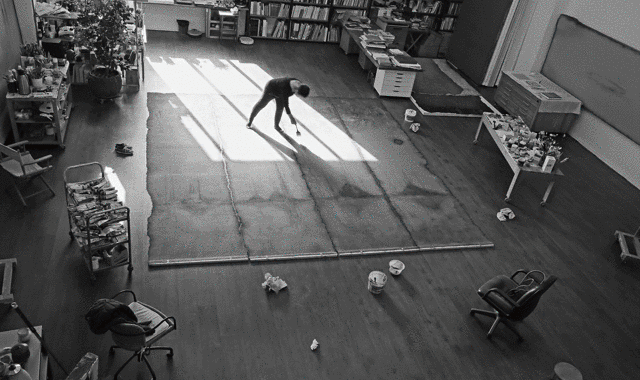
Diversified exhibitions and activities in the art field of Wuhan led people to realize that the city was gradually recovering from the huge collective trauma. “@Wuhan 2021 Chen Shuxia” as an important part of “@Wuhan 2021” at Hubei Museum of Art, her creative career from 1987 to the present day offers an overall clue and showcases over hundred works. Through the detailed presentation of different creative stages in her oeuvre, the exhibition enabled the audience to understand the challenges that the artist has initiated with boundaries of art forms and themes under the delicate and gentle appearance of her paintings.
Cultural Consciousness from Photography, Printmaking to Chinese Oil Painting
In her practice over several decades, Chen Shuxia has transcended many important creative stages and explored art carefully, thus every turn of her creation was not a whim and each has its own thoughtful conception. Since her graduation creation of a silkscreen print “Clear Air” in 1988, Chen Shuxia seems to have paid a great deal of attention to the study of art forms, while constantly defying artistic trends and trying to examine and pursue the self in her creation.

Clear Air, Silkscreen printing, 70cm×50cm, 1988
After breaking away from the modernist style in the “Primitive Colors” in the 1980s and 1990s, Chen Shuxia ushered in a change in her creation at the beginning of the millennium. With the series: “Reality and Illusion”, “Landscapes”, Chen Shuxia began to reflect on how to integrate the icons and aesthetic factors of Chinese painting especially artistic factors within Western oil paintings.
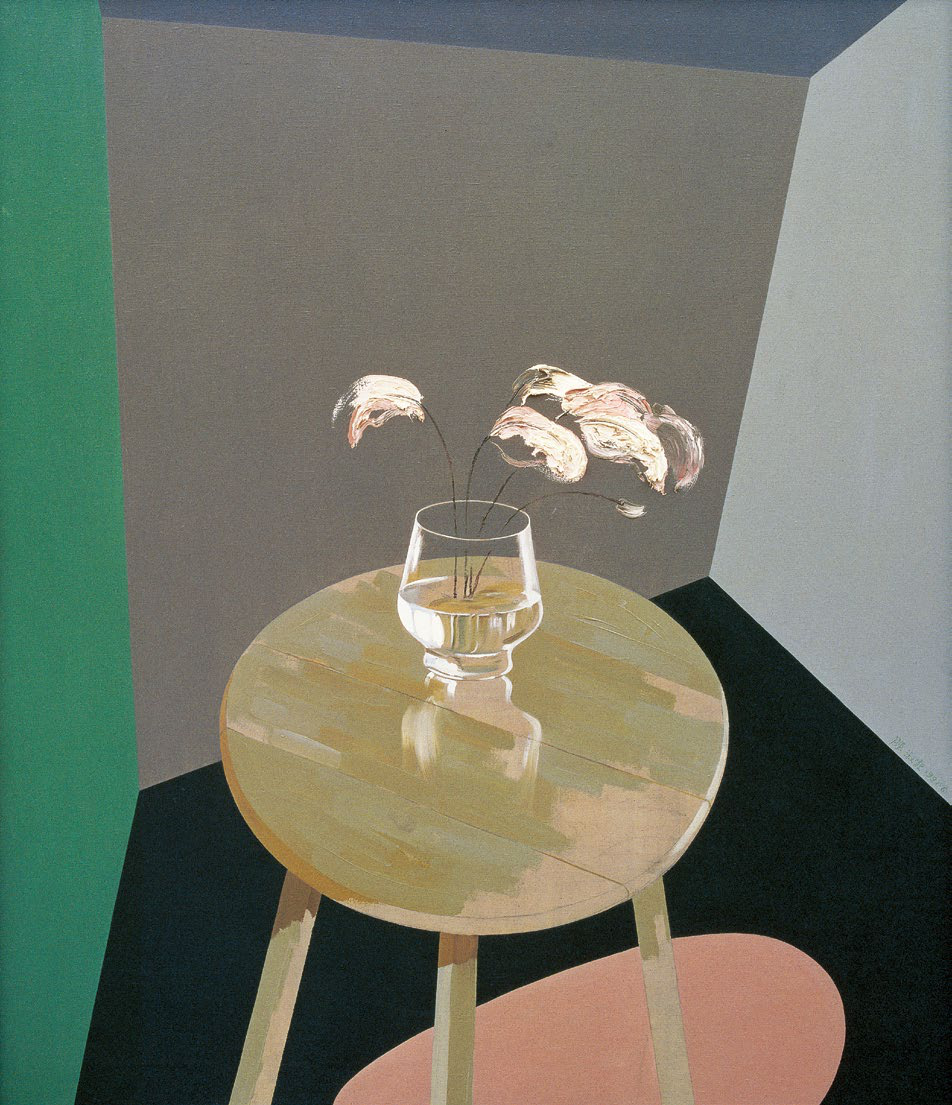
Pink Flower, Oil on canvas, 140cm×120cm, 1991
Four Apples, Oil on canvas, 140cm×120cm, 2000
Chen Shuxia’s intention to “integrate the East with the West” did not actually lie in establishing a valuable goal or creating a trend, but in self-expression. The outlook and achievement that Chen achieved in this period as Lu Hong said, “The basic creative methodology involved is a dwelling upon Western painting from a Chinese standpoint and upon traditional printing from a modern standpoint.” [1] “Reflection” may be the driving force that motivated Chen Shuxia to explore and move forward in art. What are the objects and results of reflection?
The object confronted by “integration”, on the one hand, may be the internal impulse of an Oriental person who uses Western oil painting media to create. There is no real misunderstanding when it is broadly included in the “sinicization of oil painting”, but in the details, Chen Shuxia chose to return to traditional Chinese art after the millennium and it may be regarded as an attempt by the artist to create a certain reaction and reflection on the atmosphere of the domestic art circle since the 1990s. By “returning to tradition”, she raised a question to the domestic art world which has tended to “rush forward” after the marketization of art in China: As an oil painter who started from modernism but decided to face Chinese traditions, is she a contemporary artist?
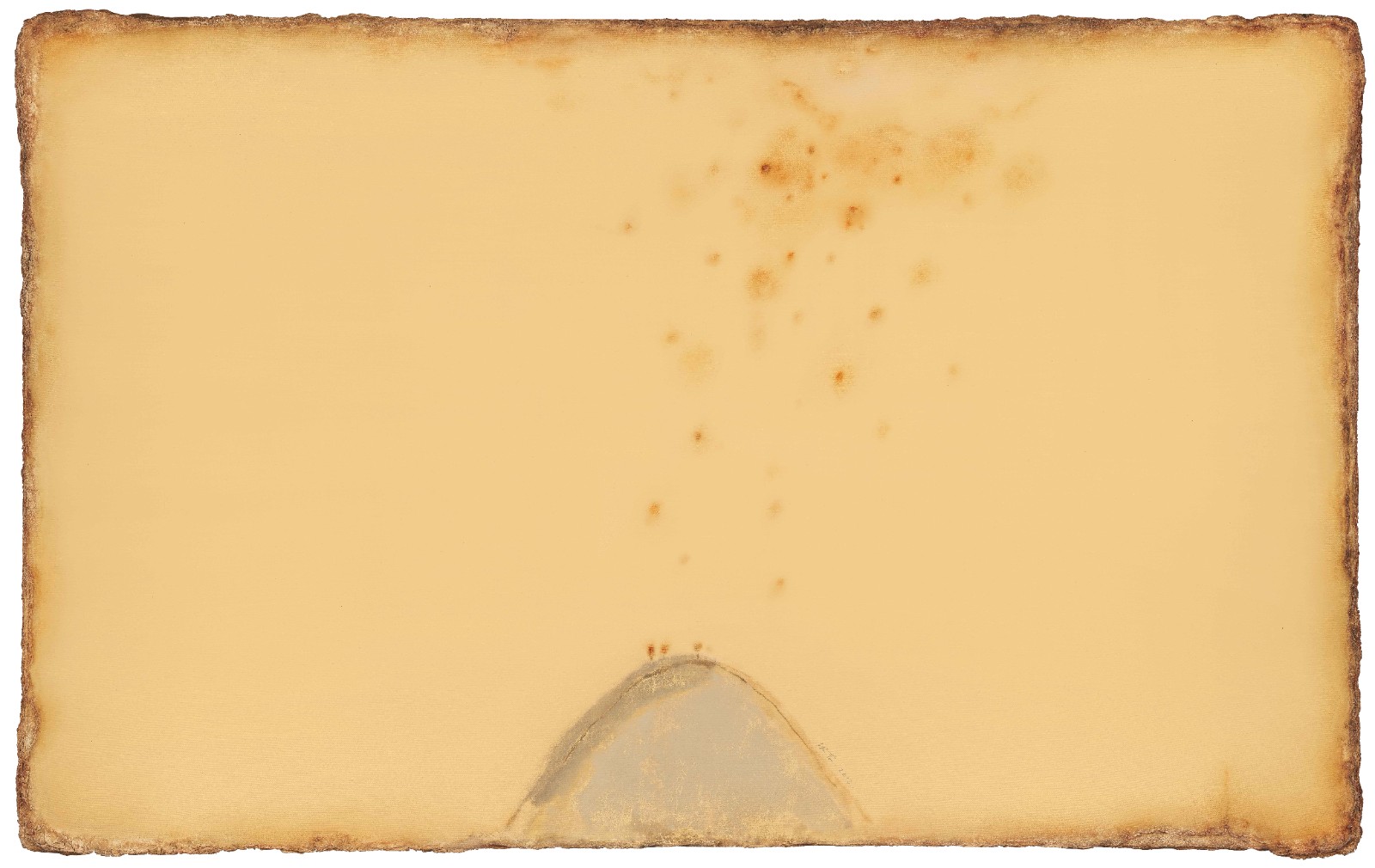
Blossom Fall, Oil on canvas, 122cm×192cm, 2013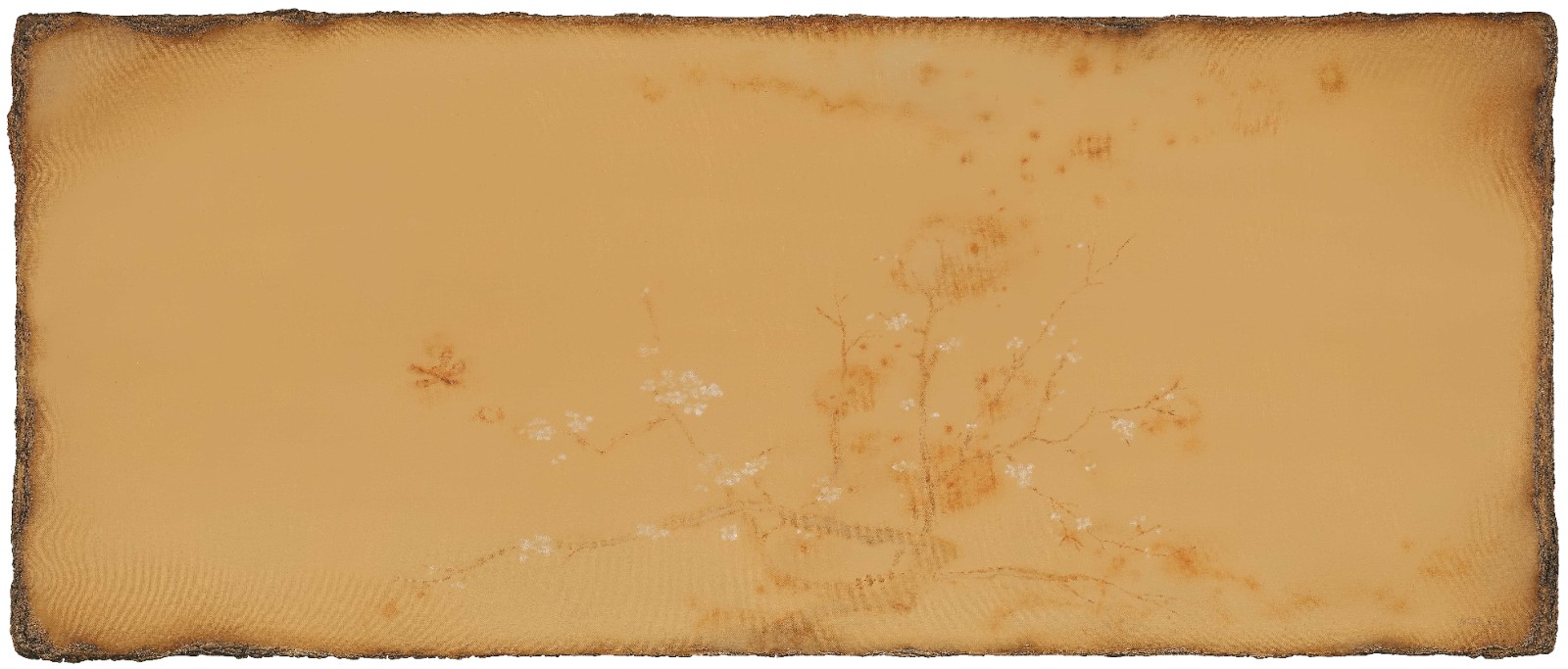
Incense Sticks, Oil on canvas, 112cm×262cm, 2014

Shallow Flood, Oil on canvas, 210?cm×360cm, 2014
Also between 2000 and 2010, Chen Shuxia developed another creative path from “sinicization of oil painting” based on similar logic. From the beginning of 2008 to 2013, Chen Shuxia’s interest in “border” has gradually penetrated into her media exploration and themed expression. From a more intuitive formal level, compared with the “Reality and Illusion” and “Landscapes” series, it draws on traditional Chinese factors, especially “Schema”. With a strong sense of form in the picture, the edge treatment of attributes in media is highlighted, allowing the “The Edge” and “Dasein” series to what Li Jun expressed, when the Eastern and Western arts deal with the “support-surface relationship”, they show thinking and discussion of two different concepts.
In the article “From Cultural References to Self-Invention—Observation of Chen Shuxia’s New Artworks” [2], Li Jun mentioned two different paths in the pursuit of flatness in Eastern and Western arts. “Traditional Chinese paintings, however, are characterized by duality of support (either silk or paper) and picture (ink brushstrokes). Ink is applied directly on the silk or paper. The ‘picture’ does not cover the ‘support’ as there is a lot of blank space left. The blank space plays a role in suggesting the material of the body or the void, the earth or even the water.”
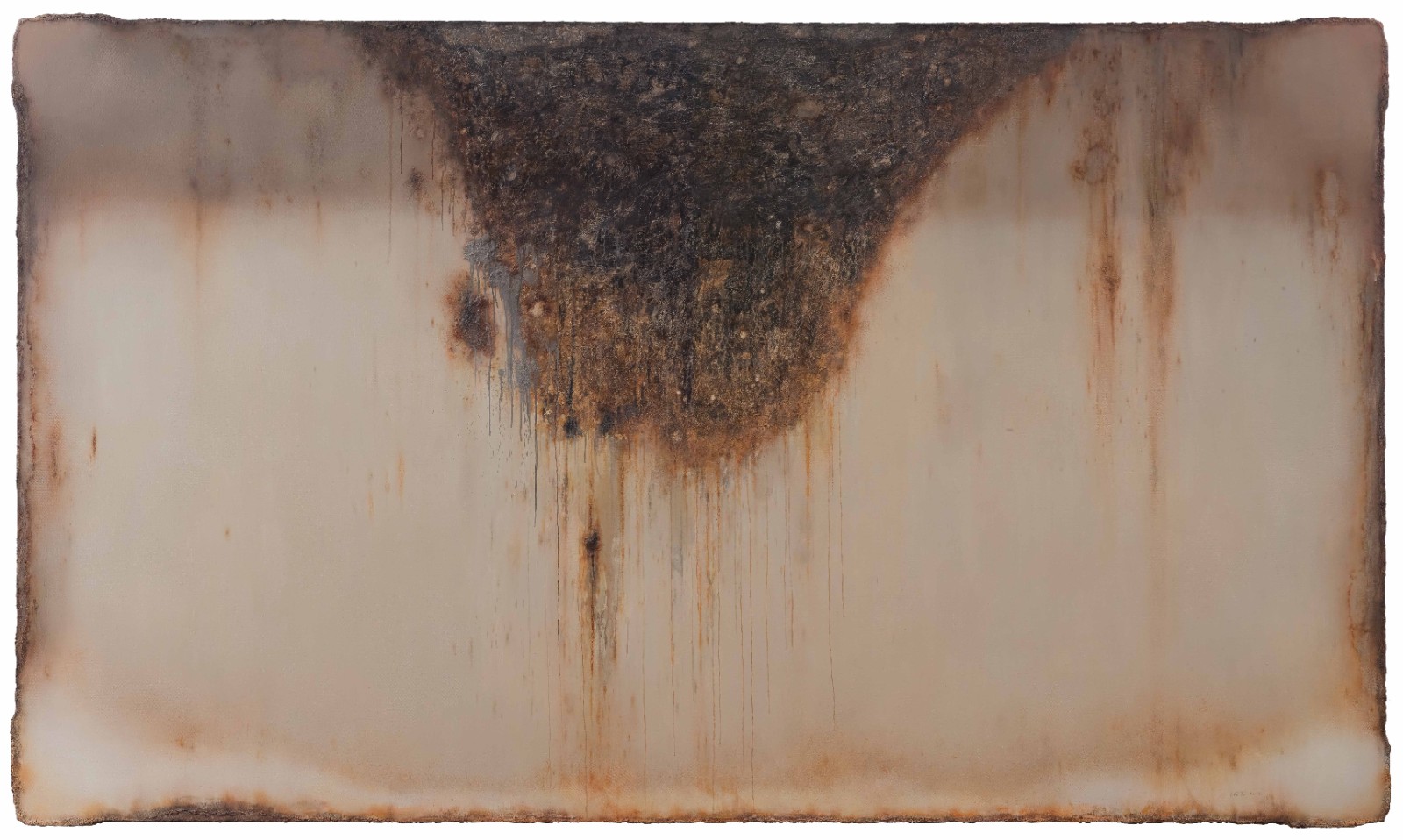
A Wall, Oil on canvas, 213cm×363cm, 2019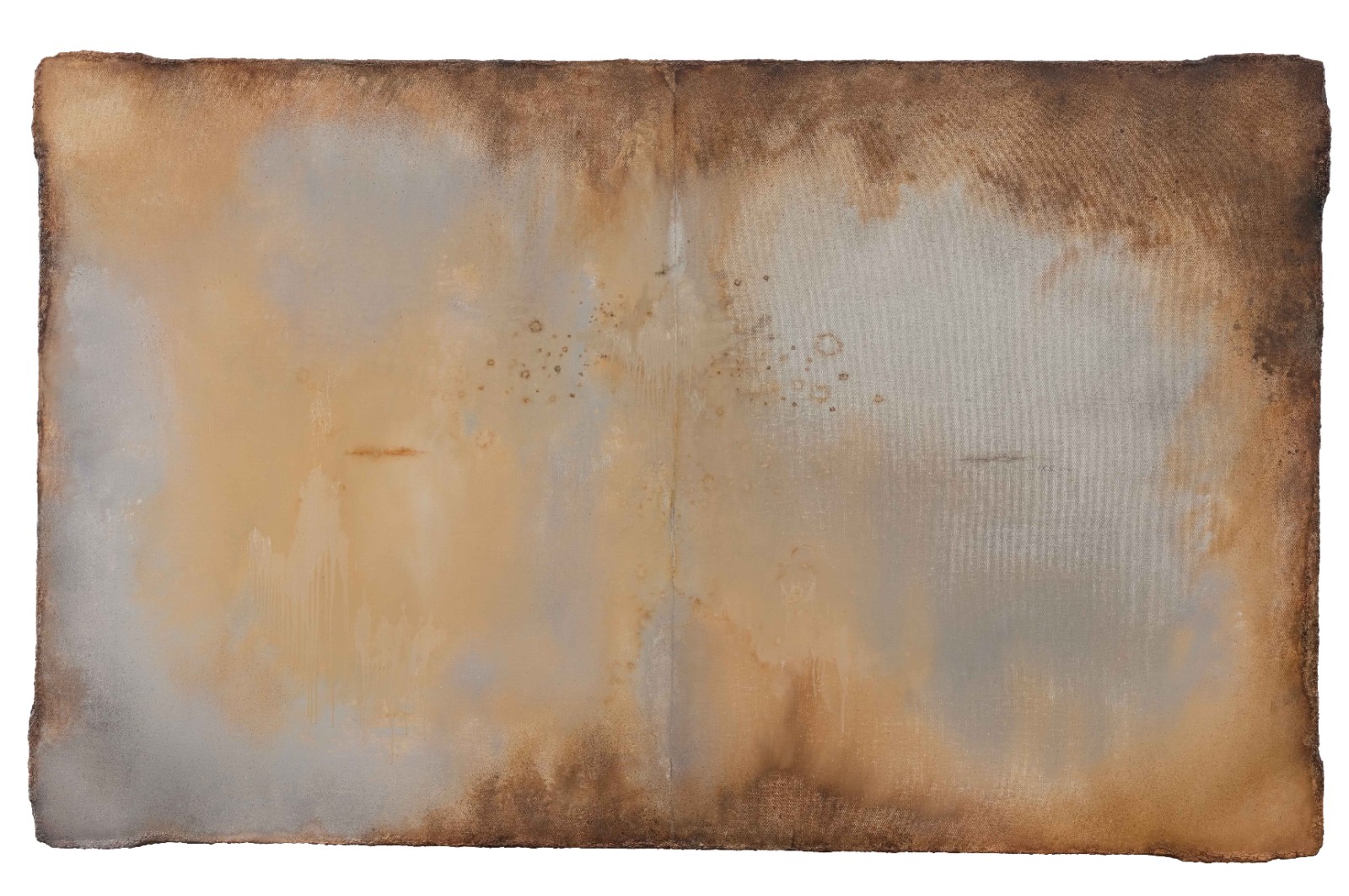
The Edge, Oil on canvas, 163cm×263cm, 2019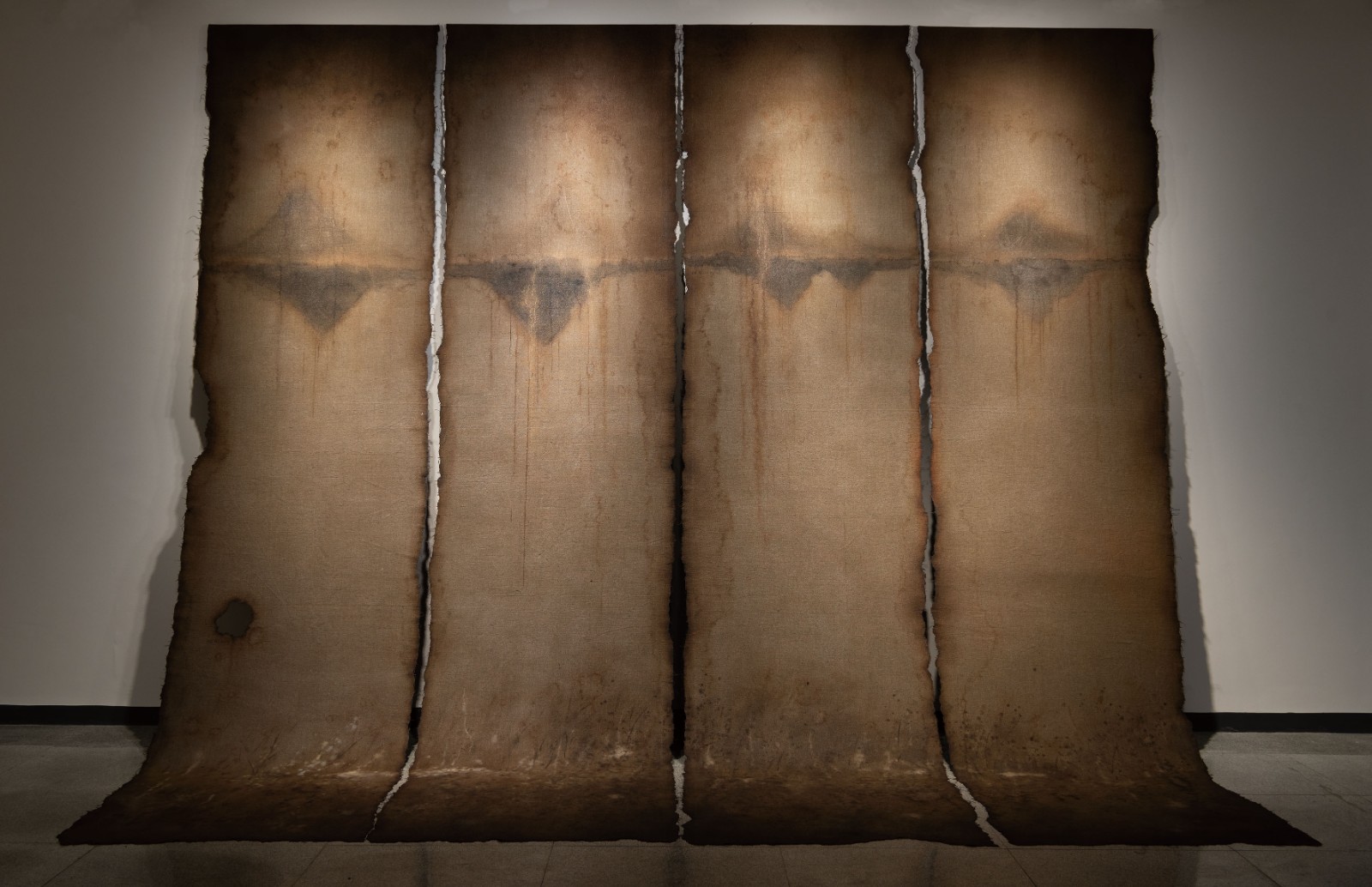 The Mountain Behind, Oil on canvas, 472cm×116cm×4, 2019
The Mountain Behind, Oil on canvas, 472cm×116cm×4, 2019
“On the material level, a distinction must be made between ‘support’ and ‘surface’ for Western oil paintings.” The “support” includes the easel and the linen cloth or canvas on it. The “surface” first refers to the surface of linen or other fibers after treatment. [3] Chen Shuxia dealt with “The Edge”, that is, actively using the ‘support’ of Western oil paintings, revealing the material basis of the ‘support’ what Li Jun said was “previously obscured by the compositional principles of Western oil paintings.” [4] This form of study on the plain nature of paintings conducted by Eastern artistic concepts and Western media enabled Chen Shuxia to introduce “ancient significance” in her oil paintings, breaking out of the frame of the embezzlement of symbolism and ancient icons.

Pieces of Words, Oil on canvas, 20cm×23cm, 2019
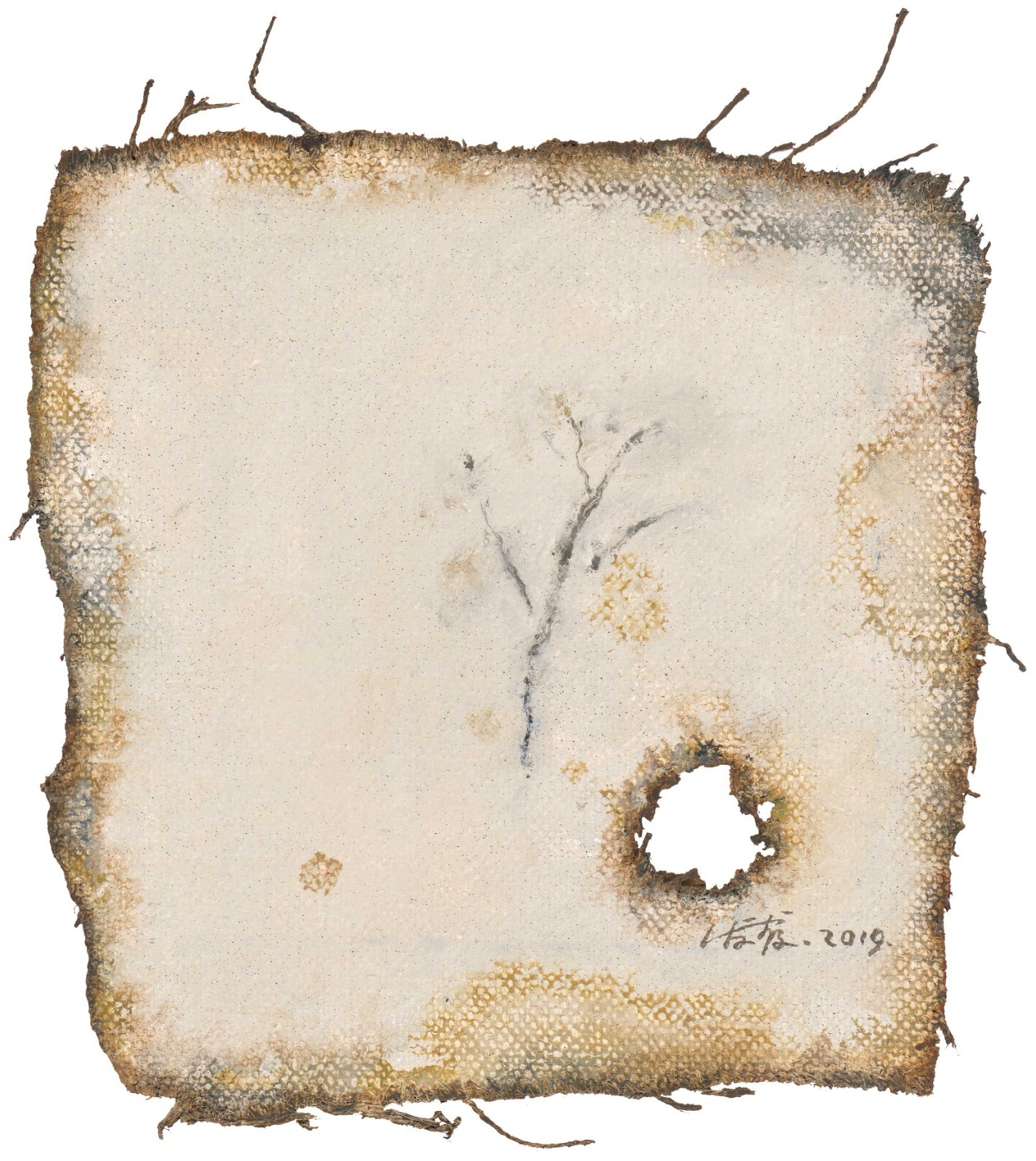
Pieces of Words, Oil on canvas, 23cm×20cm, 2019
The media and thematic expressions of “The Edge” series are unified in the concept of “timeliness”. On the one hand, timeliness runs through the creative process, “time has always been with the painter or artist, he or she lives in time, brushes spend many moments with her, and there are many moments in the painting process, they are selective to remember or express the moments.” The time of the medium is also a personal time, while the essence of its expression is the special edge created by the stacked materials—reminiscent of objects being burned, destroyed, and naturally eroded by time—symbols refer directly to ancient objects. “Antiquities” are not exactly a symbol of retro feelings, but a container of holistic time, in which all kinds of complex emotions are intertwined with historical and cultural references.
 A Real Scene, Oil on canvas, 140cm×363cm, 2019
A Real Scene, Oil on canvas, 140cm×363cm, 2019
The Green Trace, Oil on canvas, 360cm×210cm, 2021
In 2020, perhaps because of the influence from the pandemic on the soul, the artist’s thoughts and emotions about society and the atmosphere of the epoch, in the “Winning Cards” series presented in 2020, the symbol of “Winning Card” has a clearer metaphor and communication in the sequence of Chen Shuxia’s works. Together with the emphasis and treatment of the edges of paintings that continue from “The Edge”, they jointly constitute the artist’s concern about an individual’s destiny and human situation while confronting social changes.

Winning Cards-A, Oil on canvas, 58cm×38cm ×4, 2021
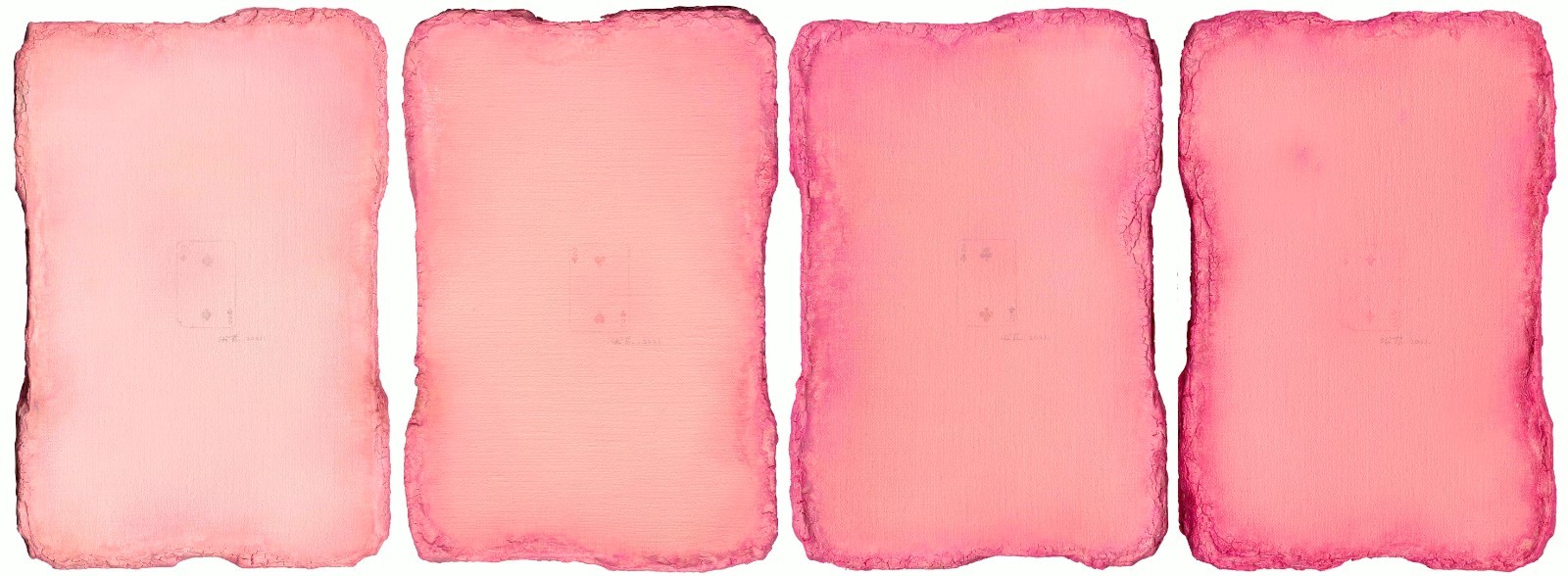
Winning Cards-2, Oil on canvas, 58cm×38cm×4, 2021
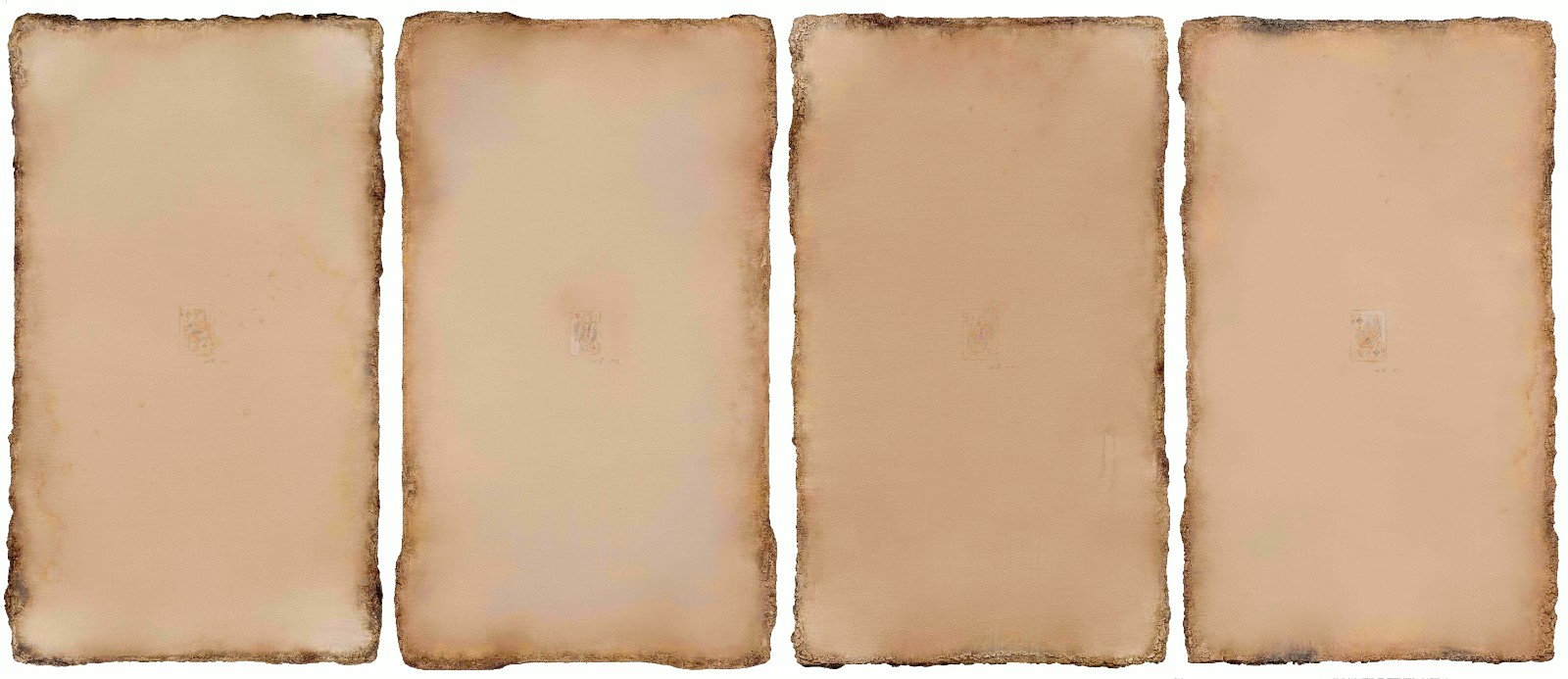 Winning Cards-Q, Oil on canvas, 122cm×70cm×4, 2021
Winning Cards-Q, Oil on canvas, 122cm×70cm×4, 2021
It is worth noting that the exhibition included Chen Shuxia’s experience of intervention in the photography creation during the third and fourth grades of her undergraduate study at the Central Academy of Fine Arts. As a group of early practitioners of Chinese art photography, on the surface, photography and her creations in the 1990s during the period under the influence of modernist artistic trends seem to have a more direct “kinship” relationship, which was far from a “return” to creations involving Chinese traditions.
For Zhi Yu, this period of Chen Shuxia’s creation which was quite detached in her oeuvre, may be related to her opposition to “image despotism”: “cameras have enabled photography to completely mechanize and fix the visual representation mechanism of traditional Western perspectivism. Through global expansion, the viewing patterns and image production mechanism of classical Western perspectivism have rejected and destroyed the original visual traditions of other cultures, conquering the world with a visual approach that lacks individuality and diversity. Perhaps the inborn sensitivity of artists is most easily activated by this image despotism.” [5] Thinking back to the end of the 1980s and the beginning of the 1990s, the situation that Chinese art photography were occupied by landscape photography had touched Chen Shuxia, so she hoped to create new forms of expression, new visions carrying new ideas of photography works. With the rendering of creative logic, photography is not a short-lived existence in Chen Shuxia’s creation. In terms of creative motives and artistic concepts, it shares very similar creative ideas with the later creation sequence that absorbs “traditional” elements.

Seeking for the Self, Photography, 31cm×25.5cm×4, 1987
However, the various voices of “opposition” made by Chen Shuxia during her creative career do not mean that Chen Shuxia is an artist who is full of “offensive” desires. Rather, it is exactly like the physical movement of painting itself, she needs to get used to taking a step back from time to time to maintain a clear and self-sustained grasp of the overall situation. Her art advocates mixing various emotions, surging on the canvas in a calm manner. A subtle sense of distance: the unpredictable and complicated painting, the white space and the aura of turpentine and stacked paint. What can be grasped by sight is a faintly shy cloud and mountain in the center of the picture, which is reminiscent of bruises, or occupying the center of the canvas like a scar. Many associations can arise from it, as a cloud mountain that is likely to come from Master Mi. The image adopts the style of accepting association, resisting being completely defined and stereotyped. Between certainty and uncertainty, it reveals a certain “temperament” in Chen Shuxia’s works.
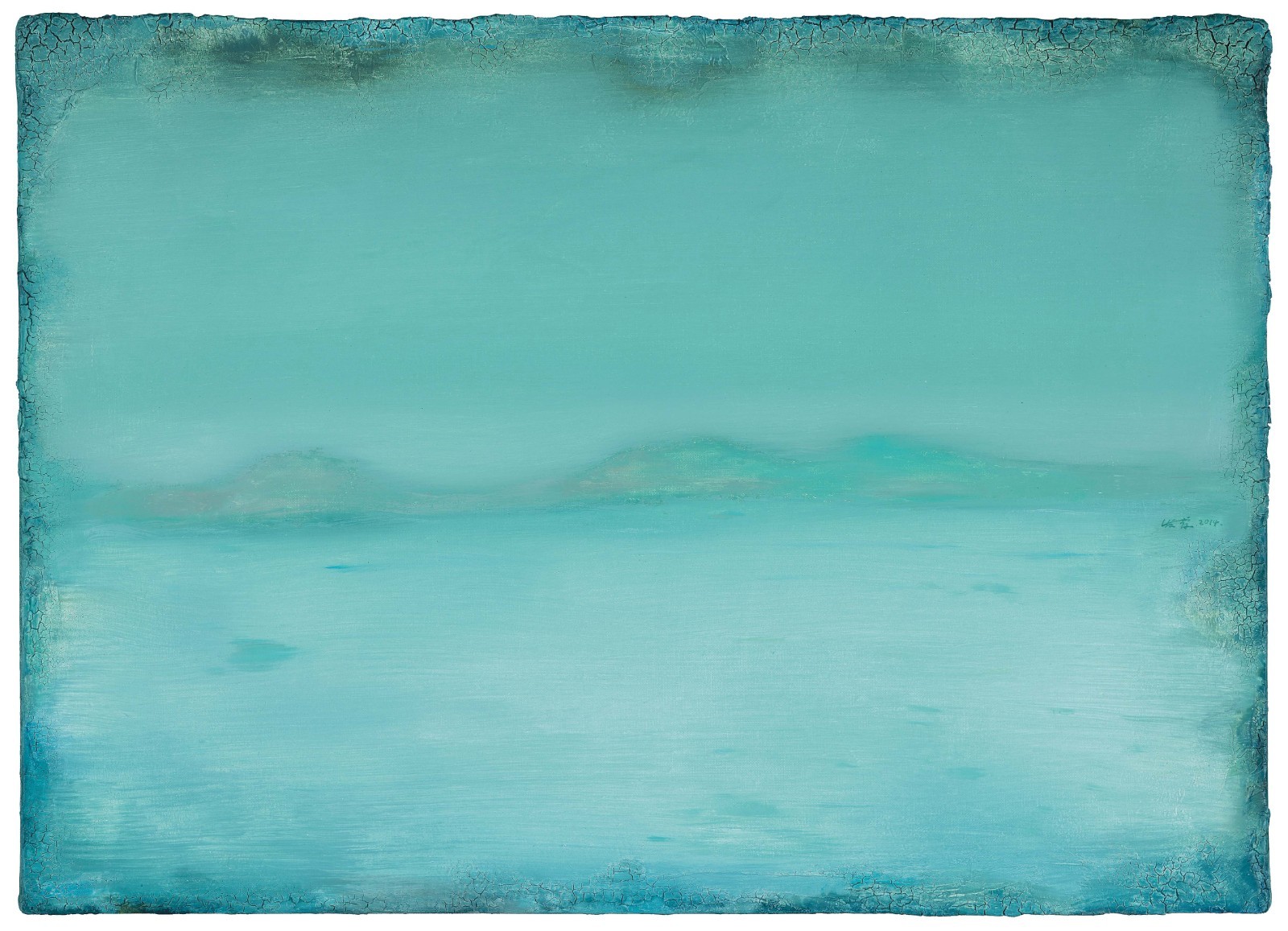
Three Greens, Oil on canvas, 80cm×110cm, 2014?
A Hesitation to Speak But She Stops—The Opposite of Over-Expression
In her creation, Chen Shuxia avoids some direct conflict, and there are rare intense color collisions or slogan expressions. As she describes—perhaps by nature and the influence of years of cultivation in the Academy, she always hopes to “make people feel comfortable when viewing her works.” This makes her creations often present a state of harmony and tranquility, but it does not mean rejecting the arrival of another kind of spectator, “Of course some people can only see here, and some people can see deeper places. But I also know that complete understanding does not exist at all.” The mild emotions cease on the surface, if with a closer look can the spectator see through the hidden contradictions and alienation behind the seeming harmony.
Factors diametrically opposed to the “peace and love” in the picture linger in the “scenery of the soul” described by Chen Shuxia. Things that are difficult to put into writing or that can be reached accurately by words are similar to a delicate mixture of thoughts, emotions, and states. The root of Chen Shuxia’s thinking and action in the picture probably lies in the tension between several groups of individuals and the outside world, including—between the artist’s academic art education and the modern art trend in the late 1980s; after the millennium, between the booming domestic art market bubble and personal artistic choices; macroscopically, it was between individual experience and changes in the social environment...the tension between several groups of relations provides the original materials and motivation for the artist’s scrutiny of society and self. Through the sensitive perception of the social environment, and the subsequent profound scrutiny and thinking, the artist implements it in the picture, creating an “aura” that is full of the artist’s personal characteristics.
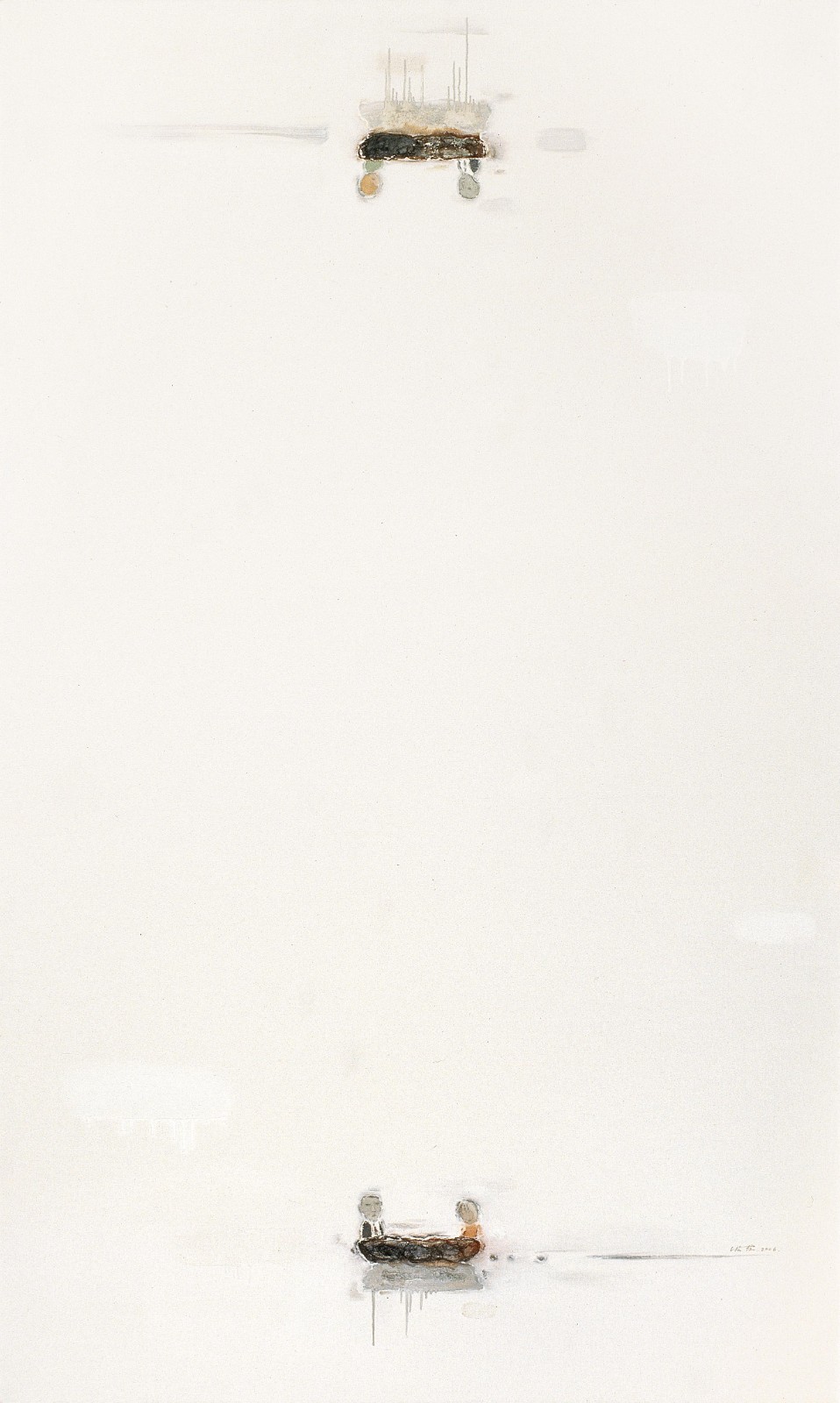
Emptiness, Oil on canvas, 260cm×160cm, 2006
In the third gallery of this exhibition, spectators can see that the important images and documents from the artist’s creative experience were all exhibited in a parallel style of text and vision. In the intertextuality, it helps the audience to understand Chen Shuxia’s art. The expression forms a richer and deeper interpretation, which is close to the core of “a hesitation to speak but she stops” in the picture.
Alienation, or it can be described as a kind of “psychological distance”, this unique and clear characteristic in Chen Shuxia’s creation is summarized as “indescribable texture” by Ji Cong in “Slow Vision—Chen Shuxia’s Indescribable Texture”. He believes that since the 1990s, Chen Shuxia’s visual expressions and schemas “all these suggest the ‘indescribable strategy’ for her continuous expressions of originality. There is neither too much narration nor too much expression; there is neither excessive intoxication nor excessive joy. A secret symbolic logic shortens the distance between the individual and the spectacle, from which a true feeling of life emerges.” [6] “A hesitation to speak but she stops” does not mean a gesture of compromise or the need for innovation.
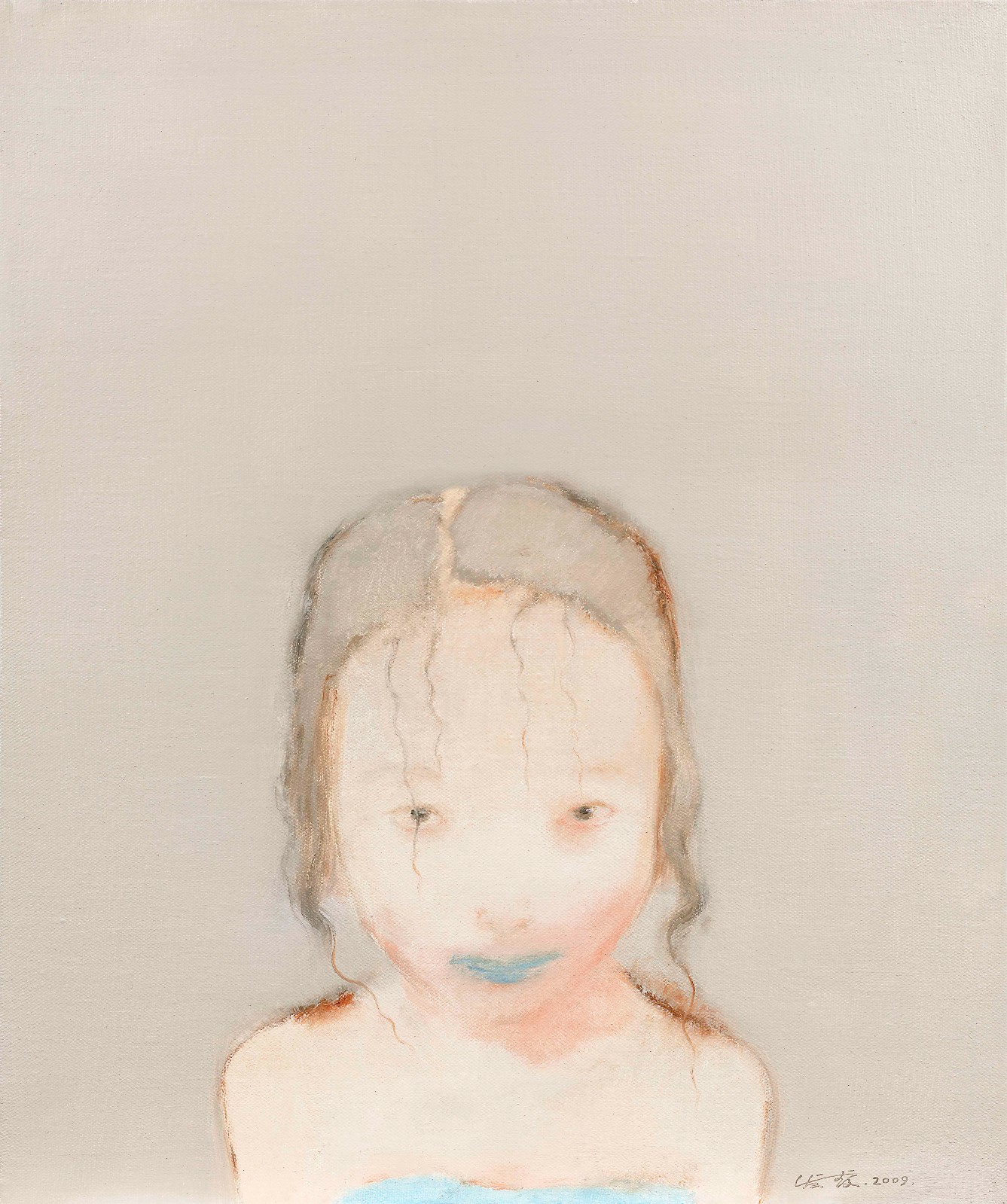
Memories of Youth, Oil on canvas, 60cm×50cm, 2009
Memories of Youth, Oil on canvas, 60cm×50cm, 2008
Chen Shuxia analyzes her “rebellious” traits in this way—in response to the generalized feedback that regards her as a female artist and makes “daily”, “physical”, “sensitive” creation, she believes that “I am a woman which cannot be changed. But everyone is always emphasizing the term ‘female artist’, why doesn’t anyone emphasize male artists? Actually, I prefer the audience to regard my work as a ‘human’ creation.” For the stage of photography creation that she devoted herself to enthusiastically, she stated that, “At that time, Chinese art photography was mainly landscape photography. I thought this kind of photography was very boring.” As for what she looked for in traditional Chinese painting, she said, “At that time, the entire art atmosphere in China was in its infancy and rapid development...I would turn it around and look for it slowly in my own works.”
The gentle rebellion and repeated adjustments to the surrounding environment are ultimately due to Chen Shuxia’s will to find self-knowledge in art. In this exhibition, she is delighted to be able to keep a little distance from her own work, that is, to herself, just like watching a newly released work, in order to calmly observe herself. The opportunity of self-examination made Chen Shuxia realize that there may be no end to the search for oneself, because everything changes endlessly and what can be determined, perhaps is only by the view of art. “It is difficult to draw conclusions about what art is like, but I think it is sacred. You can be less serious about other things, but you must be serious about creation. This is the most important basis for art, otherwise you cannot count as a true creator.”
In this way, a sort of rebellion that has always existed, in a way that is neither extreme nor intense, exists in the “distant” objects in Chen Shuxia’s paintings—they come from the present or medieval icons; and they also exist in these but are blurry, momentary and timeless fragments in the exhibition hall—they are open to people who would like to appreciate them. They have a gentle surface as light as daily life, and deeper, perhaps after repeatedly thinking, they will be torn apart, revealing even the vicissitudes of life.
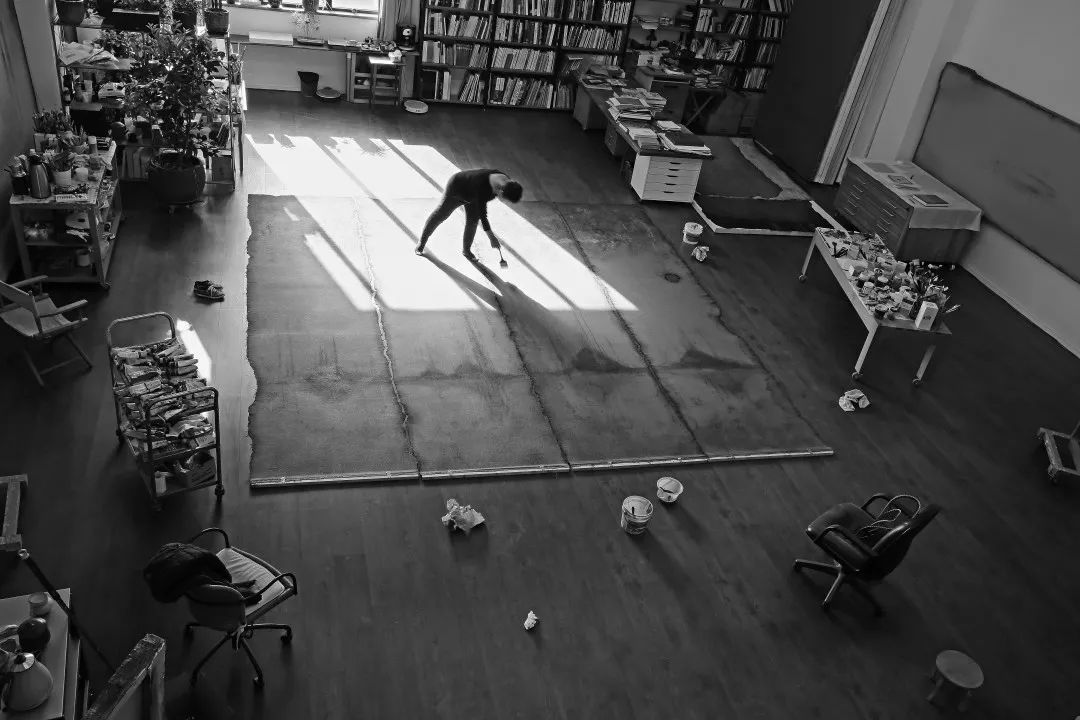
Chen Shuxia was working at her studio.
An Interview with Chen Shuxia
Interviewer: Mengxi/CAFA ART INFO
CAFA ART INFO: It can be noticed that there are theorists’ comments on your works which are attached to the walls of the exhibition halls. What role do they play in the exhibition?
Chen Shuxia: We always habitually believe that it is the audience’s own business to understand the work or not. But because I have been engaged in art education for many years, I have gradually considered the relationship between the work and the audience. Therefore, in this solo exhibition, I deliberately attach some texts besides the works, which may help the audience to comprehend the work more easily. Of course, everything still respects the audience’s subjective wishes.
These texts are mainly quoted from critics’ comments on my works. For this exhibition, I selected excerpts, so that they match the vision of the paintings and avoid becoming a counterpoint interpretation of the images. For example, for the selection of texts in Gallery 3, the literature exhibition hall usually displays the artist’s resume and works in accordance with the clues of time. In order to break away from the stereotypes, so as not to make the audience feel bored, Gallery 3 uses a parallel visual method of graphics and text to show my mentality and personal experience at different periods, and I reorganize my resume based on my changes with creative thinking.
CAFA ART INFO: What is your opinion on your own works as reviewed from a feminist perspective? Do you mind entering the list of feminist artists?
Chen Shuxia: I prefer the audience to regard my work as being created by a “human.” Everyone always uses the term “female artist”. Why does no one emphasize male artists? I think this formulation is more or less discriminatory. A certain “valuation” shows that women are placed in the position of the minority—they need to be cared for in specific terms on specific days.
Of course, I am female, and this cannot be changed. A certain difference is also reflected in the expression of “body” by different genders. As a woman, my focus on “body” in my paintings is definitely different from that of men, but I will not use it as a strategy; there are also strong emotional factors behind my paintings, but I will definitely not use any strong visual stimulation, nor will they be expressed in direct conflict. Perhaps it is due to the academic influence. I like to make people feel “comfortable” to see the picture first. They feel quiet and comfortable instead of visual stimulation, but behind the comfort there is also sadness, worries, contradictions, etc. that are not “comfortable.” Perhaps many people only see the “beautiful” side on the surface, but I believe someone will look deeper.

Rain from Above, Oil on canvas, 110cm×80cm, 2007
CAFA ART INFO: The three galleries form a whole through works. Among them, Gallery 3 organizes your previous documents and photos. Through this comprehensive editing in this exhibition, do you have different discoveries about yourself?
Chen Shuxia: As I grow older and deepen my understanding of life, I gradually feel that everyone is passive when they were born into this world. Of course, I must be grateful to my parents, but I also inevitably feel that birth is not an active choice. Now that you are passive, you must begin to think about the meaning of living. For me, the urge to find myself has continued from my youth to the present day.
For example, what is art? It is a persistent discussion in art history, and no one can give a final conclusion. When I was a student, I thought that I was thinking very clearly. Perhaps the younger I was, the easier it was to know what I painted to get good scores, and I thought I knew what to do. However, after graduation, I did not know any more. In fact, there has always been a certain “rebellious” mentality in my creation, and my graduation creation was a similar idea. No matter what the painting is, it must not be the same as others. My later attention and emphasis on the treatment of “boundary”, the sense of ancient and tradition was brought to the viewer by searching for timeliness. Now it seems that it is actually a kind of rebellion.
When I started to use traditional Chinese art elements, the entire art market in China was in the initial stage of rapid development. Probably from around 2006, the criterion for evaluating the success of the exhibition became the sales record. The impetuous, high-speed, and money-loving artistic environment has somewhat aroused my rebellious psychology. If that can also be art, I will go the other way and look for it slowly in my own works. It is difficult to draw conclusions about what art is like, but I think it is sacred. You can be less serious about other things, but you must be serious about creation. This is the most important basis for making art, otherwise you cannot be regarded as a true creator. From this point of view, self-seeking does not mean being lost, but rather it becomes my motivation. While looking back now, every stage of creation is through happiness and hardship, and my self-pursuit is still going on.
CAFA ART INFO: The experience of the photography team at the Central Academy of Fine Arts that started in 1986 was very interesting. What is the connection between photography and your artistic creation?
Chen Shuxia: I have always been interested in exploring the new visual language through photography. Many people did not know about my photography. In fact, this series of our creations attracted some attention and participated in the “Arles International Photo Festival” held in France. I started to come into contact with photography, and I was also stimulated by the fact that art photography in China was mainly landscape photography at that time. There was no digital technology, so I had to produce it myself in the darkroom, and it was very difficult to create. At that time, I had reached a level of passion for photography, and I could spend the whole day in the dark room without eating or drinking. Cameras are very important to the art of photography, and the cameras held by our classmates in the photography team were very basic. Although the equipment was not as good as professional photographers, what we discussed is the composition of the picture in the works, the creation of light, the expression of ideas and concepts in the work, and the comparison is creativity. It is not a failure if the audience feel impressed by my works.

The Shadow, Photography, 31cm×25.5cm×4, 1987
CAFA ART INFO: “The Edge” series creates a certain “psychological distance” through a formal language. I would like to ask you to talk about your original intention to pay attention to the “Boundary.”
Chen Shuxia: I moved the traditional visual focus of a painting from the center to the edge because I think the edge is also very important. This attempt began in 2008, and I officially began to create in large quantities in 2013 and 2014. It was also from that time that I don’t want to continue the visual system of Western painting in my own creations, and switch to the traditional Chinese visual system. Chinese painting contains a certain unique artistic concept, which is far beyond the core of German expressionism and abstract art, and is similar to the dramatic mode of the Peking Opera. They all have advanced elements in the contemporary field of vision.
During the creation of “Landscapes”, I began to use more specific visual language of Chinese painting, such as landscape schema and the perspective of one river and two banks, etc. In “The Edge” series, I began to incorporate the color and texture of Chinese paintings on rough paper into the images. The edges of the pictures are processed into ancient books and the ancient paintings that have a special texture such as natural fall off, decay, burnt or dilapidated, in a hope to give people a strong visual impact and direct association of “ancient” and “tradition”. The object image is not the key point in this series, so I did not paint the object image very realistically. When “The Edge” series was exhibited at the Metropolitan Museum of Art that year, there was criticism that the entire vision of this exhibition lacked change. However, constant and “slow” nature are precisely the creative ideas I want to express through visual repetition.
Tradition means precipitation and timeliness. I hope that there will be traces of time precipitation in my works, and the audience will think my works are “traditional” at first glance. Everyone is rooting in the contemporary era, and I am going to step into the “traditional.” Everyone eats quick-frozen dumplings, so I will make my own dumplings at home. As “traditional” as I am, do I still belong to contemporary artists? This is the question I want to explain and discuss through this series.
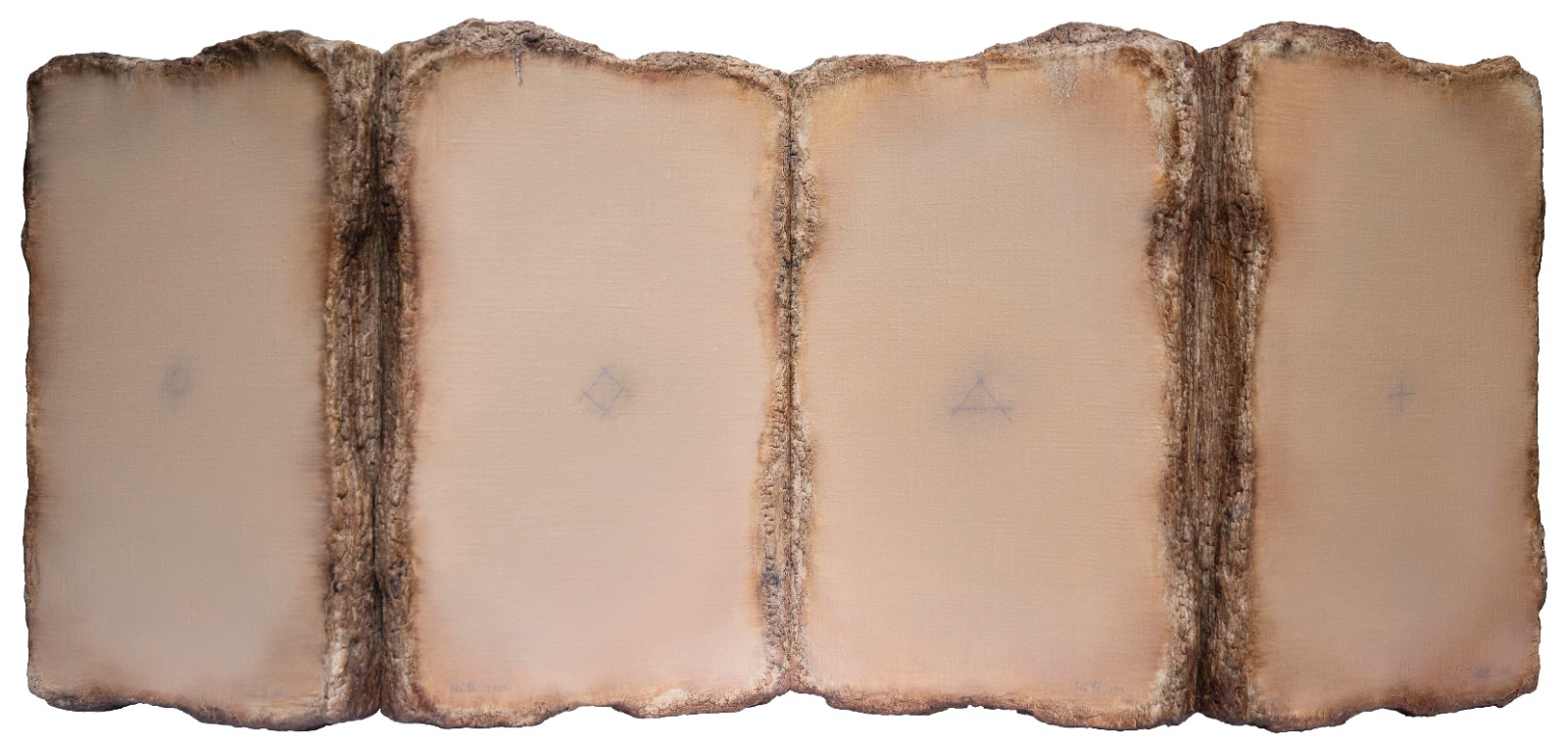
Four Tones, Oil on canvas, 56cm×36cm×4, 2021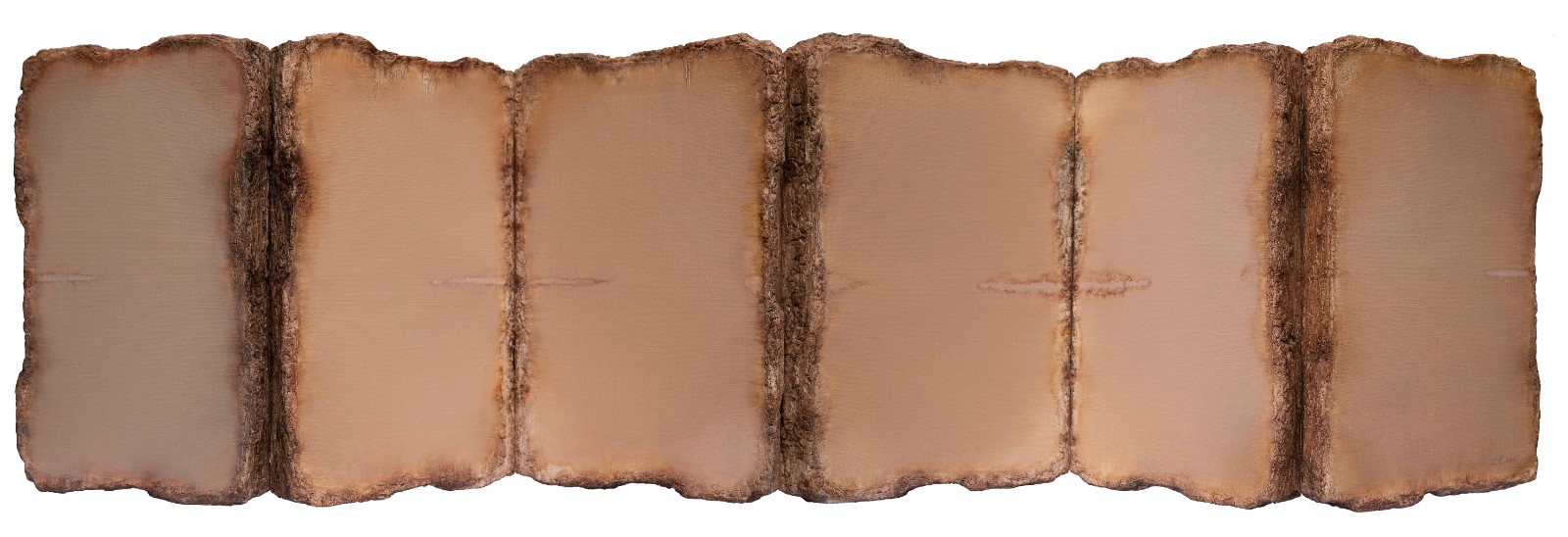
Moving Appearance, Oil on canvas, 56cm×36cm×6, 2021
CAFA ART INFO: In the “Winning Cards” series that you started to create in 2020, your symbols are relatively clear. What kind of meaning do you hope to express?
Chen Shuxia: Because of the pandemic in 2020, everyone, including me, was in a bad mood. What can artists and intellectuals do? It is inevitable to be pessimistic. But when I became more pessimistic, I moved in the opposite direction in my creations, just like the beautiful colors of the “Winning Cards” series, and the two characters in the beautiful landscape in “Landscapes”. In fact, their eyes do not meet, and humans may never be able to be truly understood.
After 2020, many people’s lives are facing a reshuffle. Too many people have caught losing cards. Therefore, the naming of “Winning Cards” also contains my expectations. I wish you all good luck when you reshuffle the cards. Of course, there is no lack of rebellious mentality among them. Since they are drawn cards, I can draw them more concretely, hoping everyone can get a winning card.
References:
[1] Lu Hong: From the “Traditional” to the “Contemporary”—Interpretation of Chen Shuxia’s Creative Transition
[2] [3][4] Li Jun: From Cultural References to Self-Invention—Observation of Chen Shuxia’s New Artworks
[5] Zhi Yu: Embodied Art and Marginal Spirit: Contemporary Value of Chen Shuxia’s Art of Painting in the Digital Age
[6] Ji Cong: Slow Vision—Chen Shuxia’s Indescribable Texture




























